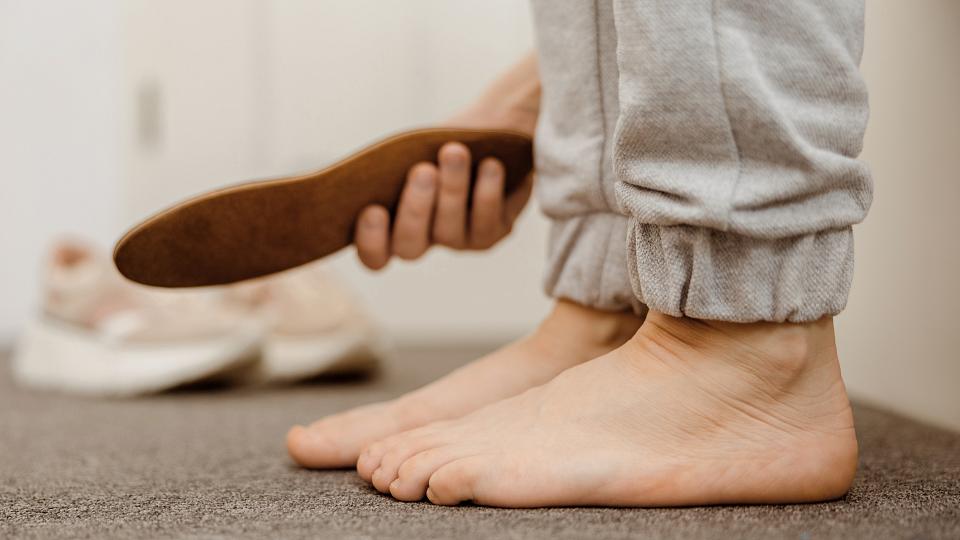
What Is a Bunion?
A bunion is a bony bump that forms on the joint at the base of your big toe. It occurs when some bones in the front of your foot move out of place. This pulls the tip of your big toe toward the smaller toes and forces the joint at the base of the big toe out of alignment. The medical term for a bunion is hallux valgus.
A bunion is a foot deformity that develops over time. Standing a lot and wearing high heels or shoes that don’t fit well can worsen bunion symptoms.
Bunion Symptoms
Bunions can occur on one foot or both. Signs of a bunion include:
- a big bump on the base of the big toe;
- redness, soreness, swelling, and numbness in the big toe;
- constant pain in and around the big toe or pain that comes and goes;
- limited movement of the big toe;
- corns and calluses (thickened skin) that develop where the big toe rubs against the one next to it; and
- difficulty wearing regular shoes due to pain.
Consider seeing an orthopedic specialist if:
- your bunion is progressing (looking or feeling worse) rapidly.
- your big toe is drifting toward the smaller toes significantly.
- pain interferes with your everyday activities, such as wearing shoes.
What Does Bunion Pain Feel Like?
Not every bunion is painful. But the pain that may occur with bunions will:
- worsen when you try to bend your toe,
- throb or feel like a burning sensation,
- extend from your big toe to the ball of your foot, and
- include shooting pain if the swelling in the toe presses against a nerve.
Bunion Causes
Experts are not sure what causes bunions. Factors may include the shape of your feet and the way you walk. You may be at higher risk for bunions if you have:
- a family history of bunions,
- foot trauma caused by an injury, or
- an inflammatory disease such as rheumatoid arthritis.
Are Bunions Hereditary?
Certain foot types can increase a person’s risk of developing bunions, and foot types run in families. If one of your parents had a natural foot type that placed abnormal stress on their big toe joint when they walked, there’s a good chance they had bunions. If you have the same natural foot type, you’re at higher risk of developing bunions yourself. People who have flat feet, for instance, are more likely than others to get bunions.

Types of Bunions
Bunions on the big toe are the most common. Other types include:
- Congenital hallux valgus—Some babies are born with bunions.
- Juvenile or adolescent hallux valgus—Children between the ages of 10 and 15 may develop bunions.
- Tailor’s bunion (bunionette)—This bunion forms on the outside base of the little (pinky) toe.
Diagnosing Bunions
An orthopedic surgeon or podiatrist will diagnose bunions by simply looking at your feet. X-rays will help the provider create a personalized treatment plan. If you decide to have surgery, a computed tomography (CT) scan will help with surgical planning.
Do Bunions Go Away?
Bunions do not go away on their own. The only way to correct a bunion is through surgery. However, non-surgical treatments will lessen symptoms and may prevent the bunion from getting worse.
Bunion Surgery: Bunionectomy
Conservative, at-home care allows many people to live with bunions indefinitely. However, surgery may be necessary when the pain becomes unbearable and interferes with daily life.
The goal of surgery is to relieve pain and correct the deformity as much as possible. This type of surgery is called a bunionectomy and is performed by an orthopedic surgeon (podiatrists do not perform surgery).
Every bunion is different. Your surgeon will tailor your surgery based on your age, general health, activity level, and condition of the bones and tissue in your foot.
A bunionectomy may involve removing and cutting portions of your bone, and repositioning surrounding tendons and ligaments around the joint. If your joint is severely damaged, your surgeon may fuse (join together) the bones. This enhances the healing process and minimizes pain.
A bunionectomy usually is an outpatient surgery and takes about an hour. If you decide to have a bunionectomy on both feet, your surgeon will likely recommend that you wait at least three months between surgeries to give the first foot time to heal.
Bunion Surgery Recovery
Recovering from bunion surgery can be challenging, especially for patients with severe bunions. After surgery, some patients need to be on crutches for two to four weeks, others for up to six weeks. Most patients need to wear a post-operative sandal or boot for two months before they can start wearing everyday shoes.
If you are physically active, you may not be able to return to your usual activities until three to four months after surgery. Some patients find it helpful to do physical therapy after surgery. Physical therapy can lessen stiffness in the big toe joint but does not speed up your recovery.
Bunions can recur after surgery. Wearing comfortable shoes can help minimize that risk.
How to Prevent Bunions from Getting Worse
Bunions develop over time. If you notice you are getting bunions, you can take steps to help slow down their progression or relieve pain. The best strategy is to wear comfortable shoes that don’t cramp your toes. Other tips include:
- wearing custom-made orthopedic inserts (orthotics) to control alignment issues,
- wearing a spacer between the big toe and second toe,
- using over-the-counter bunion pads to cushion the painful area,
- taking nonsteroidal anti-inflammatory drugs (such as ibuprofen or naproxen sodium) as needed,
- applying ice to the affected area to bring down swelling,
- putting lamb’s wool or cotton between toes that rub together, and
- maintaining a healthy weight to reduce stress on your feet.
Massage, physical therapy, and ultrasound therapy can also break up soft tissue adhesions (scar-like tissue) in your foot to reduce pain and inflammation.
Why Choose University of Utah Health?
Several orthopedic surgeons at U of U Health have advanced fellowship training in foot and ankle surgery. They only see patients with foot and ankle issues and do a large number of bunionectomies (bunion surgery), as many as 100 per surgeon each year.
This high level of experience means our orthopedic surgeons have a breadth of knowledge about bunions, which helps them develop well-informed treatment plans for each patient’s unique needs.
Find a Foot & Ankle Specialist Near You
Make an Appointment with Our Foot & Ankle Specialists
If bunions are making it difficult for you to enjoy life and be active, contact our Orthopaedic Services to make an appointment with one of our foot and ankle specialists at 801-587-7109.
Some insurance plans require that you get a referral from your primary care provider to see a specialist and have it covered under your plan. Check with your insurance carrier to find out if this is required with your plan and get a referral if necessary.





